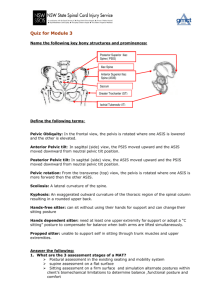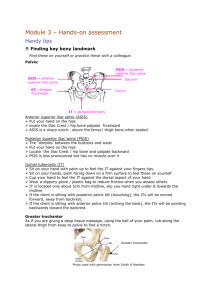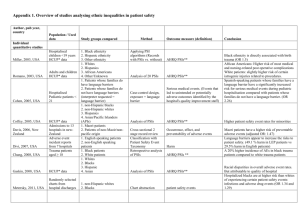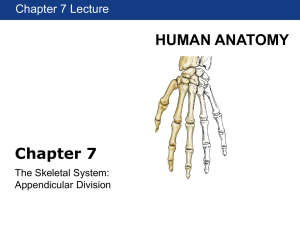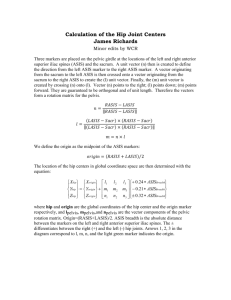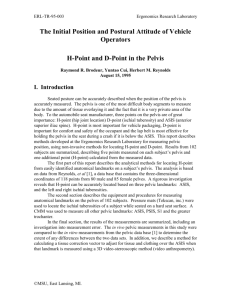Pelvic Evaluation - Myofascial Resource
advertisement
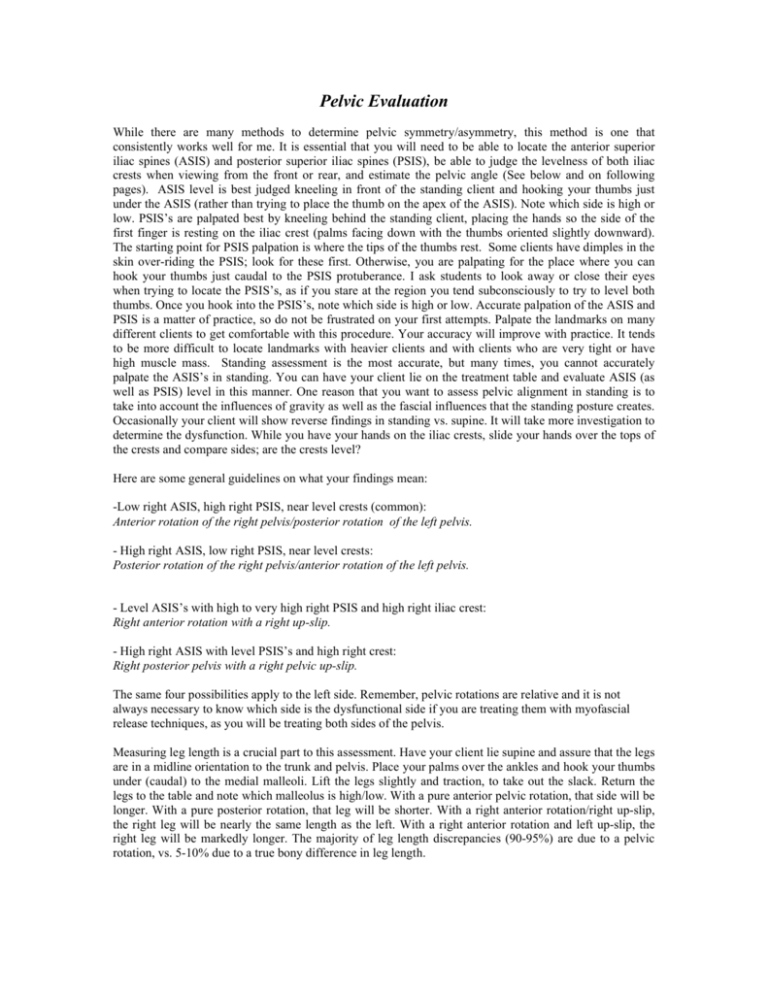
Pelvic Evaluation While there are many methods to determine pelvic symmetry/asymmetry, this method is one that consistently works well for me. It is essential that you will need to be able to locate the anterior superior iliac spines (ASIS) and posterior superior iliac spines (PSIS), be able to judge the levelness of both iliac crests when viewing from the front or rear, and estimate the pelvic angle (See below and on following pages). ASIS level is best judged kneeling in front of the standing client and hooking your thumbs just under the ASIS (rather than trying to place the thumb on the apex of the ASIS). Note which side is high or low. PSIS’s are palpated best by kneeling behind the standing client, placing the hands so the side of the first finger is resting on the iliac crest (palms facing down with the thumbs oriented slightly downward). The starting point for PSIS palpation is where the tips of the thumbs rest. Some clients have dimples in the skin over-riding the PSIS; look for these first. Otherwise, you are palpating for the place where you can hook your thumbs just caudal to the PSIS protuberance. I ask students to look away or close their eyes when trying to locate the PSIS’s, as if you stare at the region you tend subconsciously to try to level both thumbs. Once you hook into the PSIS’s, note which side is high or low. Accurate palpation of the ASIS and PSIS is a matter of practice, so do not be frustrated on your first attempts. Palpate the landmarks on many different clients to get comfortable with this procedure. Your accuracy will improve with practice. It tends to be more difficult to locate landmarks with heavier clients and with clients who are very tight or have high muscle mass. Standing assessment is the most accurate, but many times, you cannot accurately palpate the ASIS’s in standing. You can have your client lie on the treatment table and evaluate ASIS (as well as PSIS) level in this manner. One reason that you want to assess pelvic alignment in standing is to take into account the influences of gravity as well as the fascial influences that the standing posture creates. Occasionally your client will show reverse findings in standing vs. supine. It will take more investigation to determine the dysfunction. While you have your hands on the iliac crests, slide your hands over the tops of the crests and compare sides; are the crests level? Here are some general guidelines on what your findings mean: -Low right ASIS, high right PSIS, near level crests (common): Anterior rotation of the right pelvis/posterior rotation of the left pelvis. - High right ASIS, low right PSIS, near level crests: Posterior rotation of the right pelvis/anterior rotation of the left pelvis. - Level ASIS’s with high to very high right PSIS and high right iliac crest: Right anterior rotation with a right up-slip. - High right ASIS with level PSIS’s and high right crest: Right posterior pelvis with a right pelvic up-slip. The same four possibilities apply to the left side. Remember, pelvic rotations are relative and it is not always necessary to know which side is the dysfunctional side if you are treating them with myofascial release techniques, as you will be treating both sides of the pelvis. Measuring leg length is a crucial part to this assessment. Have your client lie supine and assure that the legs are in a midline orientation to the trunk and pelvis. Place your palms over the ankles and hook your thumbs under (caudal) to the medial malleoli. Lift the legs slightly and traction, to take out the slack. Return the legs to the table and note which malleolus is high/low. With a pure anterior pelvic rotation, that side will be longer. With a pure posterior rotation, that leg will be shorter. With a right anterior rotation/right up-slip, the right leg will be nearly the same length as the left. With a right anterior rotation and left up-slip, the right leg will be markedly longer. The majority of leg length discrepancies (90-95%) are due to a pelvic rotation, vs. 5-10% due to a true bony difference in leg length. The Anterior Superior Iliac Spines (ASIS) are located by bringing your thumbs up from below and locking into the notch of the pelvis. This will be just below the actual ASIS, but is an accurate method of comparing any height differential between the two sides. The Posterior Superior Iliac Spines (PSIS) are located in the manner mentioned on the previous page. Due to the presence of dense ligament and soft tissue, it may be difficult to locate accurately the PSIS’s on some clients. With practice, this will become easier. The pelvic angle is useful to determine the degree of rotation present. In the case to the left, there is an approximate 30-degree posterior tilt of the pelvis, when measured from the ASIS to PSIS. This would be an uncommon finding, as most clients will present with an anterior pelvis.
